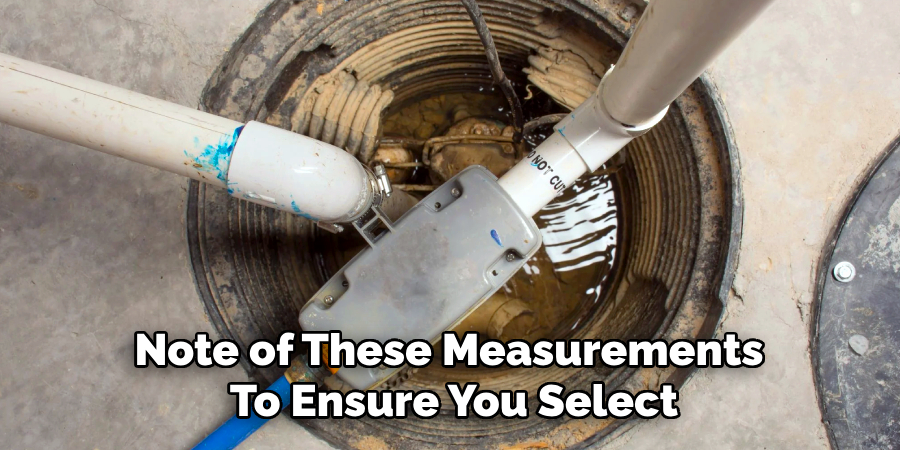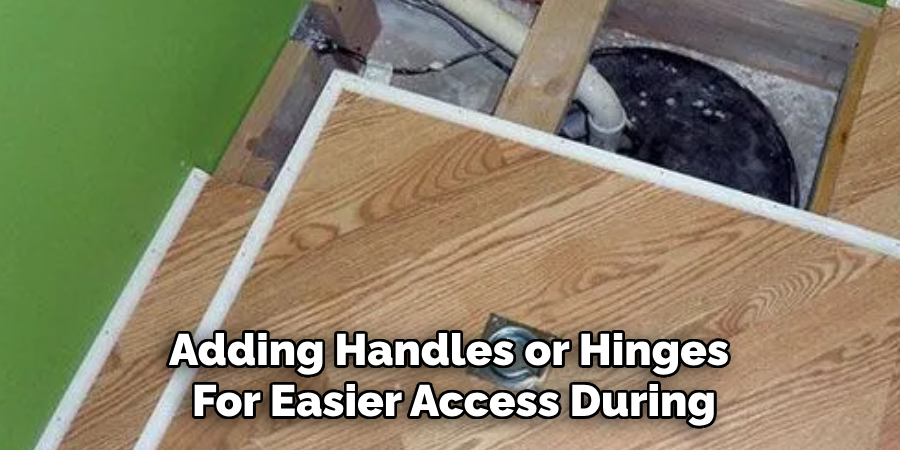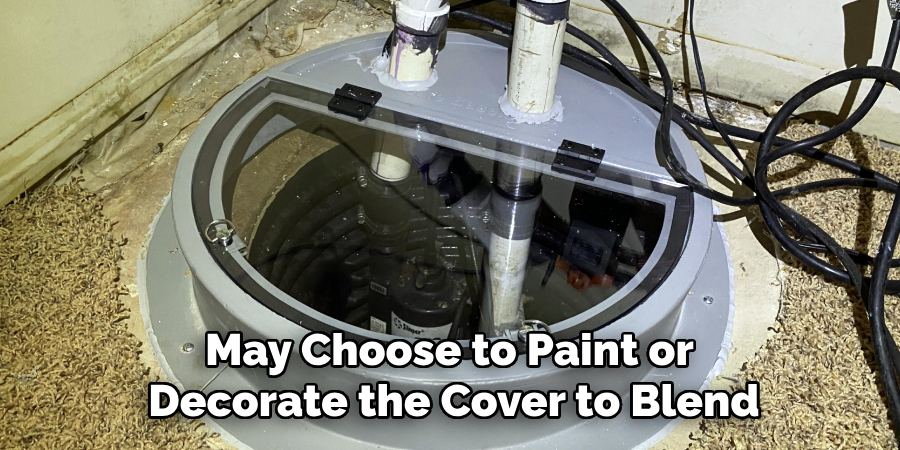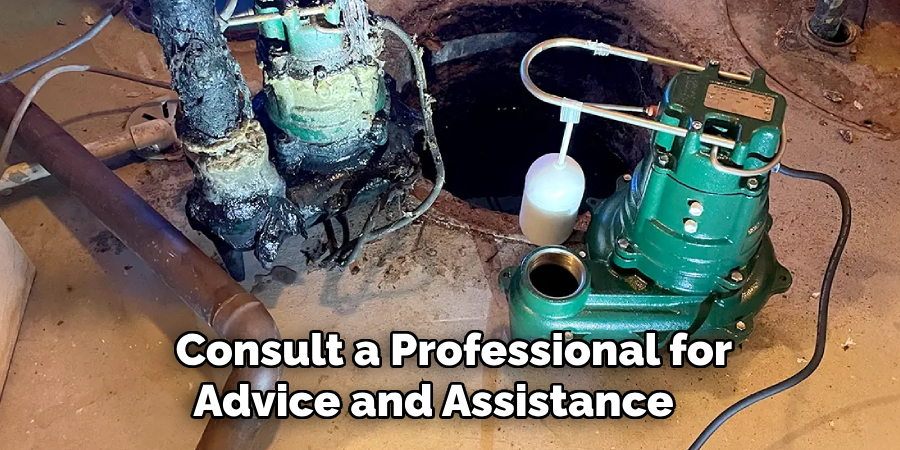A sump pump is a vital component of many homes, designed to prevent flooding and protect against water damage in basements or crawl spaces.

While functional, sump pumps can sometimes be unsightly or exposed, raising concerns about both aesthetics and safety. Properly covering a sump pump not only enhances the visual appeal of the area but also helps reduce noise and prevent debris from interfering with its operation.
This guide on how to cover a sump pump will walk you through the steps and considerations for effectively covering a sump pump while maintaining its accessibility and performance. When choosing sump pump cover ideas, it’s important to consider both functionality and aesthetic appeal to ensure they blend seamlessly with your home’s basement design.
Why Cover a Sump Pump?
As mentioned, covering a sump pump can improve the overall appearance of your basement or crawl space. It can also help reduce noise levels, especially if the pump is located in a living area.
Moreover, sump pumps are vulnerable to debris such as dirt, rocks, and leaves that can clog or damage the pump’s motor. Covering the sump pump prevents debris from entering and interfering with its operation, reducing the risk of malfunctions or breakdowns.
Covering a sump pump can also serve as a safety precaution, especially for households with children or pets. The cover creates a barrier between the electrical components of the pump and potential hazards, reducing the risk of accidents.
Types of Sump Pump Covers
There are various types of sump pump covers available in the market, each offering different advantages and disadvantages. Here are some common options to consider:
Mesh Cover:
A mesh cover is made of durable material that allows water to flow through while preventing debris from entering. This type of cover is lightweight and easy to install, making it a popular choice for homeowners.
Solid Cover:
A solid cover is made of sturdy material that completely seals the sump pump. It offers more protection against debris and reduces noise levels but may be more challenging to install and access for maintenance.
DIY Cover:
For those on a budget or looking for a customizable option, a DIY sump pump cover can be created using materials such as wood, plastic, or metal. However, these covers may not offer the same level of protection and durability as professionally made ones.
7 Steps on How to Cover a Sump Pump
Step 1: Measure the Dimensions
Before purchasing or creating a cover for your sump pump, it’s important to measure the dimensions of the sump pit and the pump itself. Use a tape measure to determine the diameter and depth of the pit, as well as the height of the sump pump and any connected pipes.

Take note of these measurements to ensure you select or construct a cover that fits properly without obstructing the pump’s operation. Accurate measurements will also help you avoid unnecessary gaps or overhangs that could compromise the cover’s effectiveness.
Step 2: Consider Material and Design
Choosing the right material and design for your sump pump cover is crucial to ensure durability, functionality, and aesthetics. Materials such as heavy-duty plastic, metal, and treated wood are commonly used for their strength and resistance to moisture. When selecting a material, consider factors like its ability to withstand basement humidity, corrosion resistance, and ease of cleaning.
The design of the cover should not obstruct the sump pump’s functionality or access for maintenance. For example, ensure the cover includes openings or notches to accommodate pipes or cords. Ventilation is another essential aspect to consider, as it prevents moisture build-up and ensures the sump pump operates efficiently. If noise reduction is a priority, opt for materials or designs that incorporate sound-dampening features. Your choice of material and design should balance practicality, durability, and appearance to suit your specific needs.
Step 3: Prepare the Cover
If you have opted for a mesh or solid cover, ensure all necessary openings and notches are cut out before installation. If creating a DIY cover, follow your chosen design and use appropriate tools to cut, shape, and assemble the cover.

For solid covers, consider adding handles or hinges for easier access during maintenance or emergency situations. It’s also recommended that ventilation holes be added if there are no existing ones in the material.
Step 4: Test Fit the Cover
Before securing the cover in place, it’s important to test fit it first. Place the cover over the sump pit and check that it fits properly without any obstructions or gaps.
If everything looks good, proceed to the next step. If not, make necessary adjustments until the cover fits snugly and allows proper access for maintenance.
Step 5: Secure the Cover
To secure a mesh or solid cover, use strong adhesive tape or screws to attach it securely to the sump pump’s lid or rim of the pit. For DIY covers, you may need to use brackets or supports to keep them in place.
The cover should not be too tight or difficult to remove, as this could impede access for maintenance.
Step 6: Add Finishing Touches
For aesthetic purposes, you may choose to paint or decorate the cover to blend in with your basement’s design. If opting for a solid cover, consider adding a latch or lock to prevent children or pets from opening it.

But remember to leave ventilation holes or slots open and accessible.
Step 7: Test the Cover’s Effectiveness
After installation, test the cover’s effectiveness by pouring water into the sump pit and observing if it collects properly in the pump. Check for any leaks or obstructions that may have been caused by the cover. Also, ensure you can easily remove the cover for maintenance purposes.
Following these steps on how to cover a sump pump will help ensure your sump pump cover provides optimal protection and functionality for your basement or crawl space. Remember to regularly check and maintain the cover to prevent any potential issues, and consult a professional if you encounter any problems with your sump pump. With proper care and maintenance, a sump pump cover can be a valuable addition to your home’s waterproofing system.
Additional Tips
- Consider adding a backup battery-powered sump pump to your system for added protection in case of power outages.
- Regularly test your sump pump and cover to ensure they are functioning correctly.
- Keep the area around the sump pump clean and clear of debris to prevent clogs.
- If you notice any issues with your sump pump, do not hesitate to contact a professional for assistance. They can help identify and fix problems before they become more serious.
- Regularly check for cracks or damage in your sump pit or cover and repair or replace them as needed.
- Consider installing a water alarm near your sump pump to alert you of potential flooding or malfunctions. This can help prevent water damage and save you from costly repairs.
- If your sump pump cover is damaged or worn out, do not wait to replace it. A properly functioning cover is essential for maintaining a dry basement.
- Always follow the manufacturer’s instructions when installing or maintaining your sump pump and its cover. Improper installation could void any warranties or cause malfunctions.
- When in doubt, consult a professional for advice and assistance. They can provide expert recommendations and ensure your sump pump cover is installed correctly. Endurance Waterproofing has experienced professionals who can help you with all your waterproofing needs, including sump pump installation and maintenance.

Frequently Asked Questions
Q: Can I Use a Cover for My Sump Pump if It’s Located Outside?
A: Yes, you can still use a cover for your sump pump if it’s located outside. Just make sure to choose a cover with weather-resistant materials and secure it properly to prevent water and debris from entering the sump pit.
Q: Do I Need a Sump Pump Cover if My Basement is Already Waterproofed?
A: Yes, a sump pump cover can still provide an extra layer of protection and prevent debris or pests from entering your sump pit. However, it’s essential to regularly check and maintain your waterproofing system to ensure its effectiveness.
Q: Can I Make a DIY Sump Pump Cover?
A: Yes, you can make a DIY sump pump cover using materials like treated wood, heavy-duty plastic, or metal mesh. Just be sure to follow the steps outlined in this guide and consult professional advice if needed.
Conclusion
Covering a sump pump offers numerous benefits such as noise reduction, debris prevention, and safety precautions. When selecting a cover, consider materials, design, and practicality to ensure optimal protection and functionality. Follow the seven steps outlined in this guide on how to cover a sump pump to properly cover your sump pump and maintain its effectiveness.
Remember to regularly check and maintain the cover, and consult a professional if you encounter any issues with your sump pump system. With proper care, a sump pump cover can be an effective solution for protecting your basement or crawl space from water damage. So invest in a quality cover today and enjoy peace of mind knowing your home is protected from potential flooding or moisture issues.
About the Author
Adrian Green is a passionate woodworking enthusiast who has dedicated his life to the craft of woodworking. From his early days working alongside his father in the family woodworking shop, Adrian has honed his skills and developed a deep love for creating beautiful, functional pieces with his hands. As the voice behind The Woodenify Blog, he shares his knowledge, tips, and inspiration with fellow woodworkers of all skill levels, helping them build confidence in their abilities while learning new techniques.
Professional Focus
- Specializes in DIY woodworking projects, from furniture making to home décor.
- Provides step-by-step guides, tips, and practical tutorials for woodworkers at any skill level.
- Focused on empowering readers with confidence and knowledge through easy-to-follow instructions and hands-on techniques.
- Passionate about building a community where makers can share, learn, and grow together in the world of woodworking.
Education History
University of Craft and Design – Bachelor of Fine Arts (BFA) in Woodworking and Furniture Design
Woodworking Apprenticeships – Gained extensive hands-on experience through various workshops and mentorships with seasoned craftsmen, refining carpentry and furniture-making skills.
Expertise
- DIY woodworking, carpentry, furniture making, and home décor projects.
- Creating clear, accessible tutorials and guides for beginner to advanced woodworkers.
- Helping readers experience the satisfaction and fulfillment of turning raw materials into stunning finished products.
